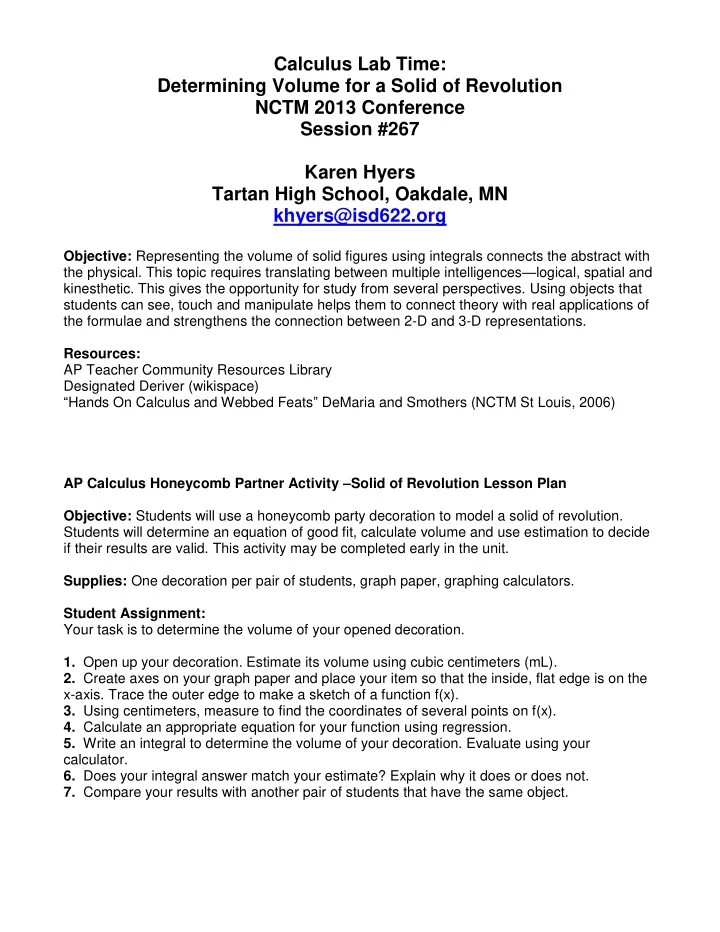

Calculus Lab Time: Determining Volume for a Solid of Revolution NCTM 2013 Conference Session #267 Karen Hyers Tartan High School, Oakdale, MN khyers@isd622.org Objective: Representing the volume of solid figures using integrals connects the abstract with the physical. This topic requires translating between multiple intelligences — logical, spatial and kinesthetic. This gives the opportunity for study from several perspectives. Using objects that students can see, touch and manipulate helps them to connect theory with real applications of the formulae and strengthens the connection between 2-D and 3-D representations. Resources: AP Teacher Community Resources Library Designated Deriver (wikispace) “ Hands On Calculus and Webbed Feats ” DeMaria and Smothers (NCTM St Louis, 2006) AP Calculus Honeycomb Partner Activity – Solid of Revolution Lesson Plan Objective: Students will use a honeycomb party decoration to model a solid of revolution. Students will determine an equation of good fit, calculate volume and use estimation to decide if their results are valid. This activity may be completed early in the unit. Supplies: One decoration per pair of students, graph paper, graphing calculators. Student Assignment: Your task is to determine the volume of your opened decoration. 1. Open up your decoration. Estimate its volume using cubic centimeters (mL). 2. Create axes on your graph paper and place your item so that the inside, flat edge is on the x-axis. Trace the outer edge to make a sketch of a function f(x). 3. Using centimeters, measure to find the coordinates of several points on f(x). 4. Calculate an appropriate equation for your function using regression. 5. Write an integral to determine the volume of your decoration. Evaluate using your calculator. 6. Does your integral answer match your estimate? Explain why it does or does not. 7. Compare your results with another pair of students that have the same object.
AP Calculus Group Lab Project – Solid of Revolution Lesson Plan Objective: Students will use an object from home as a model solid of revolution. Students will compute the volume of their object using calculus methods and then compare their result with the volume determined by submerging the object in water. Advanced Preparation: Once the concept of a solid of revolution has been introduced, students should be told to begin looking for an appropriate object. Remind them every day until you do the project. Arrange to use a lab room for 1-2 periods for this project — tables and access to a sink makes it easier. (Switch with a science or FACS class for the day.) Background Skills: Calculator regression, writing piecewise-defined functions, measuring with calipers Lab Day: Gather needed supplies. 2-3 large beakers and/or graduated cylinders, rulers, calipers, string, graph paper. Tape and scissors (to cover over holes when submerging). Procedure: Students should form groups of 3 and work cooperatively on this project. Student Assignment Sheet: Find an object of revolution at home and bring it in for this project. Objects should be about the size of your fist and be submersible. The objects cannot be cylinders, cones or spheres. You need to choose at least 2 objects from your group to complete this project. Measure everything in centimeters! 1. Sketch a graph of the function(s) that could form a region to rotate that creates your object. Use the measuring tools in class to find actual lengths on your object and plot points carefully. Be precise! 2. Calculate the appropriate equation(s) for your function(s). A piecewise-defined equation will work best for most objects. 3. Write the integral(s) that determine the volume of your object. Use your calculator to evaluate the integral(s). Round to the nearest cubic centimeter. 4. Submerge your object and compare the water displacement result with your calculations. Calculate your percentage of error. Were their any factors that would lead to large error amounts? 5. Repeat for another object. Closing: Remind the students to bring their work back tomorrow if they are not done. If finished, they should turn in their work at the end of class. Assessing Results: I give each individual a homework score for bringing in an object of revolution and each group a score (equivalent to a quiz) for the overall project. If time permits, I have the groups present their results in class.
AP Calculus Name _____________________ Chapter 7 Worksheet — Volumes of Typical Solids For each shape below: a. sketch a function to rotate around the x-axis to produce the shape b. write the integral that represents its volume using the disk/washer method c. compute the integral and check the answer with the normal formula for the object 1. A cylinder with radius 3 cm and height 4 cm. 2. A cylinder with radius r cm and height h cm. 3. A cone with radius 3 cm and height 4 cm. 4. A cone with radius r cm and height h cm. 5. A sphere with radius 3 cm. 6. A sphere with radius r cm.
AP Calculus Name _____________________ Volumes of Typical Solids part 2 For each shape below: a. sketch a function to form a footprint of the shape in the xy-plane b. sketch a typical cross section that produces the shape and find an expression for its area c. write the integral that represents its volume d. compute the integral and check the answer with the normal formula for the object 1. A rectangular prism with side lengths 3 cm, 4 cm, and 5 cm. 2. A rectangular prism with side lengths W cm, L cm, and H cm. 3. A pyramid with square base of 6 cm per edge and height of 4 cm. 4. A pyramid with square base of W cm per edge and height of H cm.
Recommend
More recommend